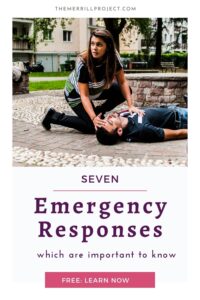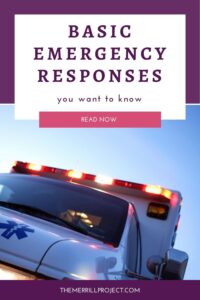
There are instances when we’re caught unaware and unprepared for an emergency situation. After all, emergencies, by definition, are unpredictable and often happen without warning to anyone, anytime, anywhere.
Thank you to Chatty Garrate for a great post!
Download Your FREE Emergency Preparedness Resources HERE
This post contains affiliate links. Read my affiliate link disclosure here
We can face countless emergencies in our lifetime. For instance, natural disasters like hurricanes and earthquakes can strike with very little notice. Man Made disasters such as fires and car accidents can happen in an instant. And then there are personal emergencies such as stroke and choking that can blindside us. So, everyone needs to know some basic emergency responses that can potentially save a life.
While we can’t predict or prevent all emergencies from happening, knowing how to respond appropriately can mean the difference between life and death.
This article will share seven basic emergency responses that everyone should know.
7 Basic Emergency Responses
Emergencies can be very frightening. In many cases, there is little to no warning before they strike. But if you know some basic emergency responses, you will be better prepared to deal with them.
*I am not a medical professional, please go take a CPR class to be certified. These are just basic tips.*
Here are seven basic emergency responses that everyone should know:
1. Breathing Emergencies
Basic CPR or Cardiopulmonary Resuscitation is a life-saving technique used when someone has stopped breathing, or their heart has stopped beating due to an accident, drowning electric shock, or a heart attack. It can also help keep the victim’s blood and oxygen circulating until medical help arrives.
Basic CPR Tips (I am not a medical professional, please go take a CPR class to be certified. These are just basic tips.
- If someone is not breathing, start by performing mouth-to-mouth resuscitation.
- If the person is not responding and their heart has stopped beating, you will need to perform chest compressions.
- Place the heel of your hand on the breastbone in the center of their chest, and then place your other hand on top and interlace your fingers.
- Use your body weight to administer compressions at a rate of 100-120 per minute.
2. Choking (Heimlich Maneuver)
Choking is a common emergency that can happen to people of all ages. It occurs when an object gets lodged in the throat or windpipe, blocking the flow of air that can cause breathing difficulty and be life-threatening if not treated immediately.
Choking First Aid Tips – Heimlich maneuver
- Have the person choking stand up and lean forward to open up their airway.
- Give them five firm back blows between their shoulder blades with the heel of your hand.
- If the object is still lodged, you must perform the Heimlich maneuver.
- Stand behind the person and wrap your arms around their waist.
- Make a fist with one hand and place it just above their navel.
- Grab the fist with your other hand and give a quick, upward thrust. Repeat this until the object is dislodged.
3. Heat Exhaustion
Heat exhaustion is a condition that can occur when someone is exposed to high temperatures, causing the body to sweat excessively and leading to dehydration. And if not treated immediately, it can progress to heat stroke.

Basic Heat exhaustion First Aid Tips
Download Your FREE Emergency Preparedness Resources HERE
- If someone is suffering from heat exhaustion, move them to a cool, shady area and have them lie down.
- Loosen their clothing and give them small sips of cool water.
- Apply cool, wet clothes to their skin or have them take a cool shower.
- If their symptoms (headache, nausea, fatigue, and lightheadedness) worsen, or they develop heat stroke, then call 911 immediately.
4. Bleeding
Bleeding is an emergency caused by an injury or accident. This emergency is very common, so knowing how to treat it can prevent further damage and infection is essential.
If the bleeding comes from a vein, it will be dark red and steady. You can control this type of bleeding by applying pressure to the wound with a clean cloth. However, if the bleeding comes from an artery with bright red blood spurting out in pulses, it’s a medical emergency, and you should call 911 immediately.
Basic Bleeding First Aid Tips
- Apply direct pressure to the wound with a clean cloth.
- If the bleeding is coming from an artery, apply pressure to the artery with your fingers.
- If the bleeding is coming from a vein, apply pressure to the wound with your palm.
- Apply pressure for at least five minutes or until the bleeding stops.
- If the bleeding does not stop, then call 911 immediately.
5. Burns

Burns are a common injury that can occur from heat, chemicals, or electricity exposure. There are three types of burns: first-degree, second-degree, and third-degree.
First-degree burns only affect the outer layer of skin and are typically not severe, while second-degree burns affect both the outer and inner layers of skin and can be painful. Third-degree burns are life-threatening since they damage all layers of skin and underlying tissues.
Basic Burns First Aid Tips
- If someone has a first or second-degree burn, hold the affected area under cool running water for at least five minutes.
- Apply a cool, wet cloth to the area or use a cool compress. But do not put ice on the burn.
- If the person has a third-degree burn, call 911 immediately. Do not remove their clothing or apply anything to the area.
- If the person is conscious, have them lie down and cover them with a clean, dry cloth.
6. Seizures
A seizure is a sudden change in brain activity that can cause involuntary muscle contractions and convulsions. If someone is having a seizure, staying calm and not trying to restrain them is crucial.
Basic Seizure First Aid Tips
- Clear away any objects that they could hurt themselves on.
- Protect their head from injury by placing a pillow or blanket under their head.
- Do not put anything in their mouth.
- If the seizure lasts longer than five minutes, call 911 immediately.
- Once the seizure is over, help the person to a sitting position and stay with them until they recover.
7. Fire
Download Your FREE Emergency Preparedness Resources HERE
Fire is a common hazard in the home and can cause severe injury or even death. While hazard insurance will help with the financial aftermath, it can’t replace lost lives. So, staying calm and acting quickly when there’s fire is vital to surviving.
Basic Fire Safety Tips
- First, try to extinguish the fire with an appropriate fire extinguisher. But if the fire is too big or you can’t extinguish it, evacuate the area immediately.
- Do not use elevators. Use the stairs instead.
- If you are trapped, stay low to the ground and cover your mouth with a wet cloth.
- Call 911 immediately and give them your location.
Final Tip
It can be challenging to think straight when you’re in the middle of an emergency. However, staying calm and thinking clearly is essential to help you assess the situation and take appropriate action.
Basic first aid knowledge can be the difference between life and death, so find time to familiarize yourself with these basic emergency responses. And remember, when in doubt, always call 911. They are trained professionals who can help you in any situation.
Thank you Chatty Garrate
Download Your FREE Emergency Preparedness Resources HERE
If you liked this post, please let us know. Leave a comment below and click those share buttons to tell your friends. As always, we appreciate you taking a minute of your time to spread the word about preparedness.
